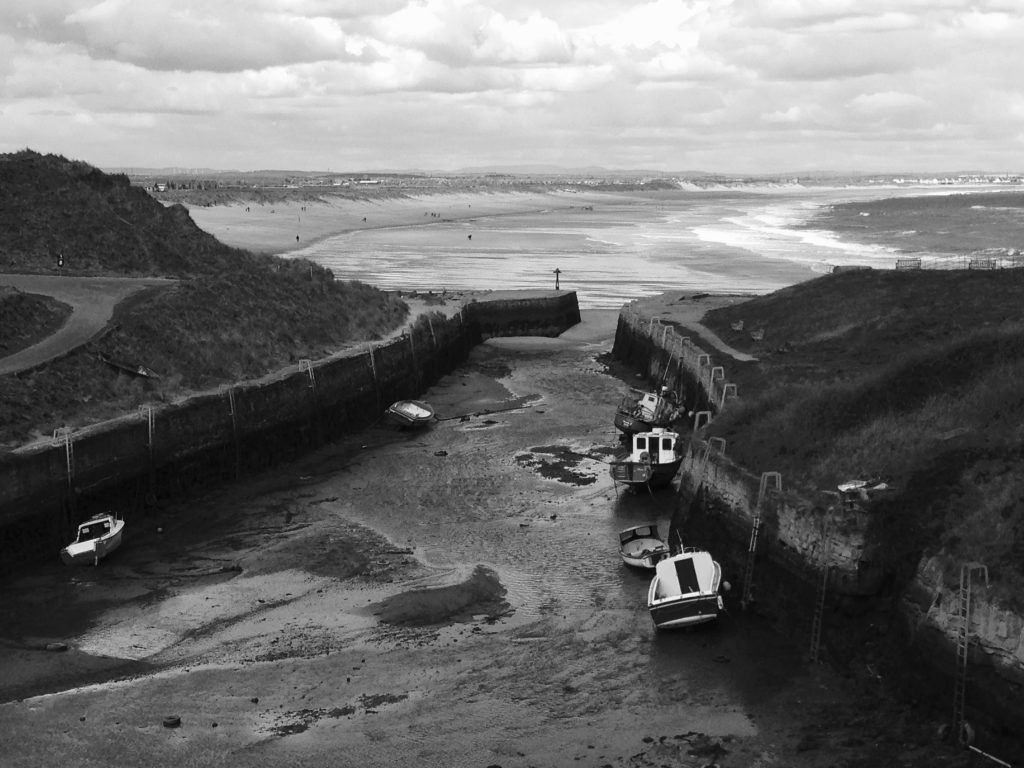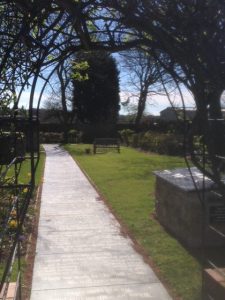
The Cut at Seaton Sluice
My 26 Steps journey took me from North Shields to Old Hartley – two locations on the coast of North East England, close to Newcastle upon Tyne.
North Shields, at the mouth of the River Tyne, I knew well. A cheerful quayside of fish and chip shops, fishmongers and fishing boats, where characters walk in white coats and wellies, or queue outside the steaming windows for a salt and vinegar fix.
Old Hartley I had to look up on a map. It’s just a little further north, up the coast, close to and easily confused with its near neighbour Seaton Sluice.

I began my walk at the quayside, stepping into dozens of stories. A small fleet of brightly coloured boats nestling beneath the watchful white tower, suggesting fishing, and sea-shanties. A wooden figurehead stands outside the pub, waiting for sailors’ return.
Further back in time, the whaling crews set sail and the dreaded press gangs raided the town for skilled boatmen. And, like all coastal towns there are tales of shipwreck, lives lost and lives saved by the brave efforts of coastguard and lifeboat volunteers.
Along the coast at Tynemouth, a ruined priory looks out over the water. A scene of benediction and wreckage – a place that’s been a sanctuary for soldiers and the sick, but also served as a gun battery, protecting the shipyards along the river from bombing raids.
Keeping the sea to my right, soft golden sands give way to clear blue waters where surfers glide. Sandcastles, ice creams, rock pools, sunny days. At Cullercoats, an artists’ colony, drawn by the quality of the light.
Further north, the white dome of Spanish City, scene of former amusements, overlooks the seaside town of Whitley Bay. St Mary’s lighthouse perches over a sea-washed causeway and rocks where you can sometimes spot a seal or two.
But it was at New Hartley, a small collection of houses that’s easily mistaken for its near neighbour Seaton Sluice, that I began to find the inspiration for my piece. The green banks that rise along the shoreline were once home to heavy industry. The remnants of the cone shaped furnaces of the glass bottle works still visible if you look closely.
The <a href=”http://www.seaton-sluice.btck.co.uk/”>Seaton Sluice and Old Hartley local history society website</a> provided a rich seam of information about a time when ships by the hundred visited the harbour to carry bottles produced at the Hartley glassworks around the world.
This industry, which helped create the wealth of the local Delaval family, was fuelled by 30 or more pits in the area near Hartley where the coal was mined. This lead me from New Hartley to Old Hartley, site of the former pit and a devastating mining disaster in 1862.
The Hartley mining disaster
I walked round the memorial garden at the Hester pit site. A series of slate stones bear the names of the 204 men and boys who died when the beam, which supported the pump to clear the mine of sea water, split and crashed down, blocking the mine’s shaft and their only way out.

While some were killed outright. Many more survived, only to be trapped, falling victim to mine gas or starvation over six days as rescuers sought to reach them. It’s a tragic tale, made all the more vivid when you walk the streets and realise the impact of the loss on this relatively small community.
The accident happened at shift change, so there were more workers in the mine than usual. The tally tokens they left when they went down the mine would never be collected. Queen Victoria sent a message of condolence and extra land was made available at Earsdon for the burials.
I didn’t want to write a cliche of North East mining disaster, but after walking round the memorial site and reading the words on the stones, the story wouldn’t leave me. A sunny day with spring flowers blooming provided stark counterpoint to the dark story that happened long ago and far below the green earth.
The coal hewn from Hester and other local pits fuelled the great furnaces that produced glass bottles at the nearby works. To ship those bottles around the world, a deep cut was made into the land to make it easier for ships to pass through. It’s still known locally as ‘The Cut’.
Connecting these two hidden stories together, as they were once connected in real life, provided the theme of my poem. Industry here, changed the land and hence the people forever.
You can read my poem and trace the map of my route at 26 Steps.

Comments are closed.